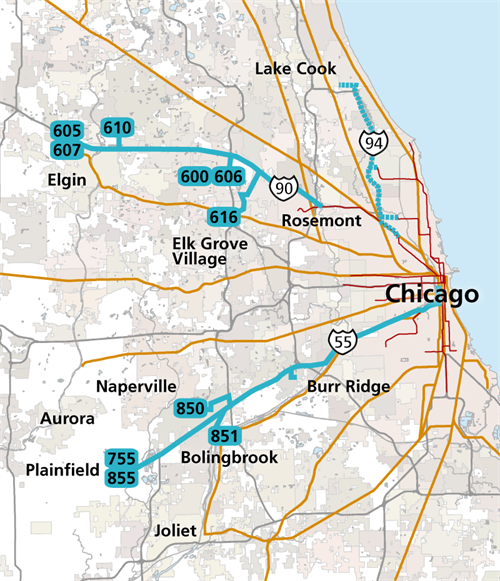
Flickr user Steven Vance (cc).
Pace is on the fast track toward more riders with its express bus services.
Published monthly, MPC’s Talking Transit, supported by Bombardier, provides updates about transit-related activities around the world. Read In the Loop for the latest transportation headlines.
Did you know?
Metro Transit, which provides transit service throughout the Minneapolis-St. Paul region, now offers 300 miles of bus-on-shoulder service, allowing express buses to bypass congestion on highways. This bus-on-shoulder system, which is made possible by improvements to highway shoulders, has been extended virtually everywhere in the area since it was introduced in 1991 and serves thousands of buses daily. It is a cheap mechanism to significantly improve the service provided by express buses.
The buses using highway shoulders are authorized to take advantage of those lanes when traffic is moving slower than 35 mph. When in place, the shoulder lane improves reliability and speed of bus service, making the system more attractive. Since Metro Transit implemented the bus-on-shoulder system, regions around the country—from Seattle to the North Carolina Triangle to Washington—have implemented similar networks.
Express service on I-55 shoulders has significantly increased ridership
Pace, the Chicago region’s suburban bus operator, introduced its own bus-on-shoulder operations in 2011 thanks to a change in Illinois state law allowing the service. The Ill. Dept. of Transportation spent $9.5 million on upgrades for I-55 on 15 miles of the highway from downtown Chicago to Plainfield, Ill., about an hour southwest of Chicago. These improvements are pretty much as cheap as it gets when it comes to transit investments, far less costly than urban rail construction or even more traditional bus rapid transit.
As a pilot, Pace began service with two routes—755 and 855—serving Plainfield, Romeoville, Burr Ridge and Bolingbrook, 45 and 60 minutes south of the city, respectively. These routes already existed but were allowed to use the bus-on-shoulder lanes. The benefits were immediate: On-time performance, for example, improved from 68 to nearly 95 percent.
By mid-2013, the buses were attracting significantly more riders, roughly doubling their typical daily ridership, as the following graph shows; this change led Pace to add new trips on the lines, including service off-peak.
By mid 2014, ridership had continued to increase, and Pace added even more service and divided the 855 into three separate routes—850, 851 and 855—to accommodate increased demand and simplify the route structure for the benefit of new customers. These routes now provide 50 total trips daily, and ridership is now more than six times what it was in 2011. The pace of increase does not appear to be slowing.
Though the total daily ridership of the I-55 lines remains low compared to some of our region’s top-performing bus lines (about 1,200 daily riders, versus about 30,000 for the Chicago Transit Authority Ashland Avenue bus, for example), the rate of increase demonstrates clearly that improvements in reliability and speed make a difference. Even more service is now planned. People will ride the bus if it’s a reasonable option.

I-90 is getting a network of its own express routes
Pace’s service on I-55 is performing so well that the Illinois General Assembly approved a bill last year making the original bus-on-shoulder pilot project permanent, and extended the program to make it legal on all Chicago-region expressways and tollways.
Pace’s short-term plans are to bring similar bus-on-shoulder routes to the I-90 tollway northwest from Rosemont to Elgin. The reconstruction of that highway, almost completed, includes shoulders designed specifically for buses, and Pace has developed a new service plan both for routes that currently use I-90 and new routes that will take advantage of the faster service and several park-and-ride lots constructed nearby.
The Illinois Tollway, which reconstructed I-90, also plans to eventually provide bus-on-shoulder service on the Elgin-O’Hare Western Access highway, now under construction.
Pace plans even more into the future
The Chicago Metropolitan Agency for Planning provided $38 million in Congestion Mitigation and Air Quality funds for the I-90 project, and it is also investing $10 million to improve shoulders on I-94 running north from Jefferson Park in the city north to the Lake Cook corridor. The following map shows how these three services could extend from the center of the region. The Pace express corridors (in blue) complement the Metra services (in orange) and will improve suburban transit accessibility.

In the long term, Pace has a plan to bring bus-on-shoulder services to virtually all of the region’s highways, creating a 230-mile network. These improvements will complement the Pulse arterial rapid transit program Pace has underway on Milwaukee Avenue.
Pace is playing an important role in improving access to transit in the Chicago region through its bus-on-shoulder program, but it will not be able to expand its network further without significant new investments. Accelerate Illinois is working in Springfield to identify new funding sources for transportation to make better transit possible.